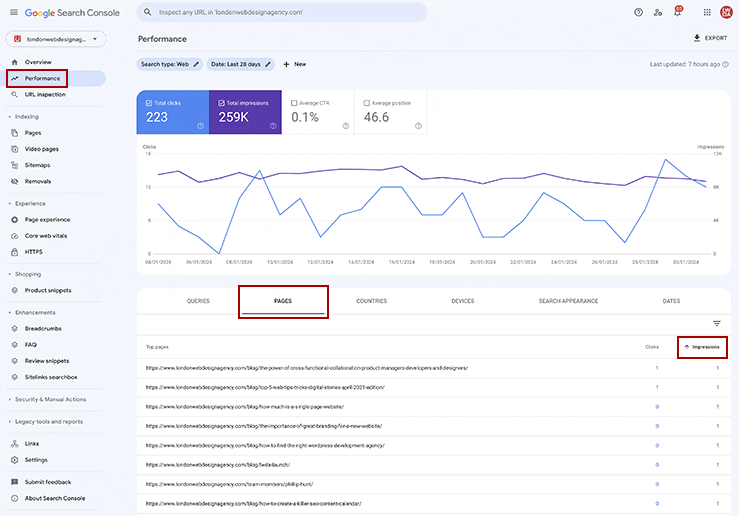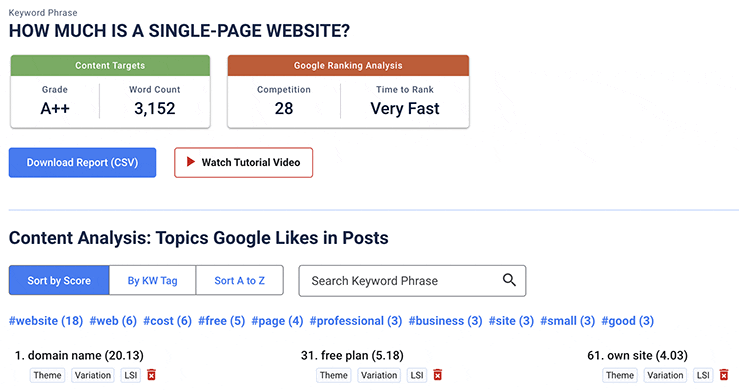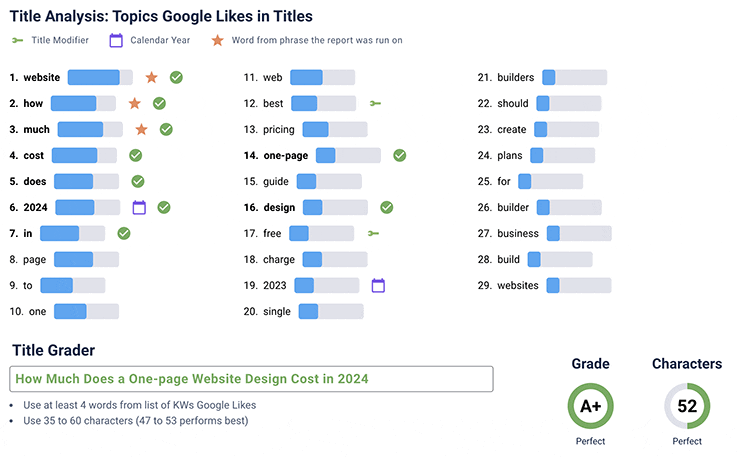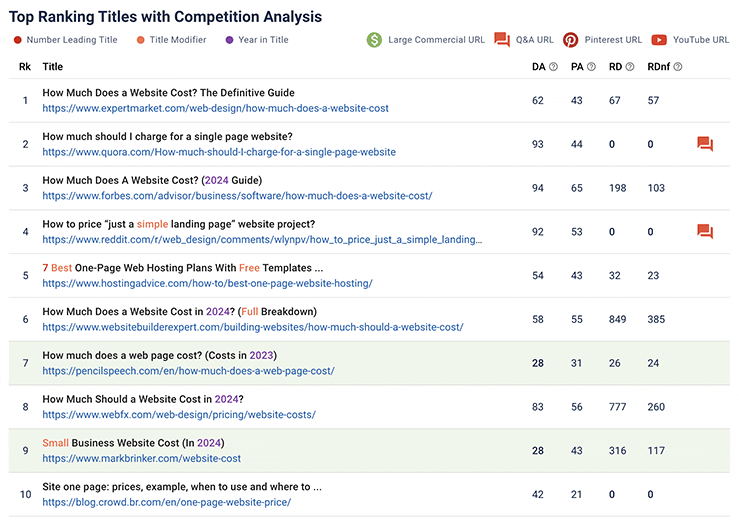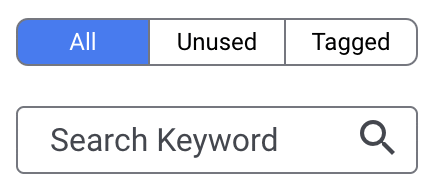
Article
How to use RankIQ to Update Old Posts and Improve SEO
PUBLISHED:February 7, 2024
UPDATED:March 14, 2024
In the ever-evolving landscape of SEO, keeping your content updated is crucial for maintaining visibility and relevance. We’ve written about refreshing old content before, and how important it is as part of your ongoing strategy, but now we have a range of AI tools that can help make the job easier and quicker to obtain the results we’re looking for.
One powerful AI (artificial intelligence) tool that aids in this process is RankIQ. We’ve been experimenting with this powerful tool at LWDA and have started to see some positive results with older posts gaining more impressions and clicks than when they were created.
At this stage, it’s important to state that this is NOT a sponsored post. This is an honest RankIQ review and tutorial, based on our current use cases, ease of use, and its validity as part of any content creators’ SEO toolset.
So, with that out of the way, let’s explore how you can leverage the help of RankIQ to breathe new life into your old posts and supercharge your SEO strategy.
Understanding RankIQ
RankIQ is a comprehensive SEO tool designed to analyze and score content based on various parameters. With its intuitive features, it provides valuable insights into how well your content aligns with current SEO trends and algorithms.
RankIQ is good for assisting in the creation of brand-new blog posts as well as editing old posts to help improve Google search results. This article will focus on the latter.
Why Update Old Posts?
Outdated content exerts a substantial influence on a website’s SEO rankings, as users actively seek fresh and relevant information. Regular updates are not merely a choice but a necessity to remain competitive against similar businesses.
We’re not all natural writers, with many of us developing content creation skills over time. This means that there’s a high chance that our old posts are a little lacklustre and could do with a bit of an overhaul.
Content improvement usually focuses on the following:
- Post Length – The Yoast SEO plugin may encourage us to write at least 300 words, but in today’s market, Google – and visitors – are looking for in-depth articles that are truly informative and educational. So you’ll need to go far beyond the 300-word mark.
- Keyword Density – A longer post length delivers the opportunity to include more relevant keywords, each of which can increase organic search traffic.
- Out-of-date info – If you’ve got an old post containing facts, figures or instructions that were correct at the time, chances are they’re now out of date.
- External links – Following on from the above, you may have posts that include links to sources which are also out of date, so you’ll need to find some new sources and update those links!
- Internal Links – Linking to other pages on your website should be a part of your ongoing SEO strategy, and optimising old posts is the perfect opportunity to add some more internal links where relevant.
The demand for up-to-date content reflects a user base hungry for the latest insights, trends, and information, underscoring the importance of continuous efforts to ensure that your website remains a go-to source for information. Regularly updating old posts is one way to ensure this.
Benefits of Using RankIQ for Updates
By incorporating RankIQ into your content strategy, you can enjoy several benefits for content updates. From improved keyword optimization to an overall enhancement in content quality.
When using Rank IQ to update old posts, the key resource that we find beneficial is the Keyword Library. Many online keyword tools deliver their keyword suggestions based on Google Adwords data, which isn’t good for bloggers because Google Ads focus heavily on only one keyword per use case. These tools also require a large amount of manual work to sift through all of the keywords and build a list of those which may be of use. This inherently allows for a lot of user error. RankIQ on the other hand pulls its data from a broader set of suggestions and produces the list of suggested keywords for you, saving hours of your time.
Step-by-Step Guide to Updating Posts with RankIQ
Unfortunately, there is no free version of RankIQ, but at the time of writing, the monthly subscription fee is only $50 which is quite a lot less than some other tools. At this price point, we reckon it’s well worth a punt just for the first month to test things out.
1. Accessing RankIQ Platform
Once you have registered, start by logging into the RankIQ platform and make sure that you are on the Reports page. This is where you will set up and monitor the status of all of your reports. A report is a page or post that you are optimising.
2. Selecting Posts for Updates
Your next task is to identify the blog posts on your website that could benefit from a refresh. There are tools within RankIQ that can help you do this, and for more details on that, you should watch the tutorial video on the Reports page. But for this review, we’ll be using Google Search Console.
If you have not already registered with Google Search Console, then now is the time. GSC is a great tool for finding old underperforming posts, and alongside Google Analytics, should form a part of your SEO strategy toolkit.
Once set up, simply click the Performance option in the left-hand-side menu, and then click the Pages tab in the data view. You can then click Impressions at the top of the far right-hand column. Click again to switch to the lowest number of impressions first.
From here you can easily identify which posts are performing badly. Find the post that you most want to optimise and mouse over the URL. The row should highlight and reveal 3 icons, the middle of which will open the post in a new window or tab.
3. Creating your First Report
Now that you’ve identified the post that you wish to optimise, simply copy and paste the title into the Run New Report input box on the Reports page and click Run Report. In this instance we are going to look at our article; How Much is a Single-page Website?
It’s worth a note here to say that if your post title is quite long, you may want to just use what you feel is the main key phrase within the title. For example, this post that you are reading now might only require the phrase ‘How to use RankIQ’ instead of the entire title.
Once RankIQ has finished analysing your keyphrase, it will produce a new report and take you directly to the report page.
4. The RankIQ AI SEO Report
The RankIQ SEO Report is very easy to decipher. Even for beginners. The report breaks down as follows:
Content Targets
Quite simply, the Grade is the score that you should be aiming for when optimising your post, and the Word Count is the suggested number of words that RankIQ believes you will need to write to hit the desired grade.
Don’t be put off by the number of words you see. The truth is that this is just an estimate. I have optimised posts with almost half of the number of words and still obtained an A++ grade. BUT, be careful not to indulge in keyword stuffing, which is frowned upon by search engines. You need to get the balance between using just enough keywords to get the grade you want, plus a post that reads like a human would talk and flows naturally.
Google Ranking Analysis
The Google Ranking Analysis shows the level of competition your keyphrase and how quickly RankIQ believes it will take to rank in the SERPs. The lower the number, the lower the competition.
Download Report CSV
For more serious users, you have the option to download a CSV file of the entire report, which includes everything further down the page. Great if you want to keep a record of your reports on your computer or upload to some online storage.
Content Analysis: Topics Google Likes in Posts
This section contains your list of keywords. By default, the list shows your top keywords related to the keyword phrase sorted by score, which is how important they are to your post, with the higher numbers being the most valuable.
You can tag keywords by Theme, Variation or LSI. All of these are explained in the tutorial video on the RankIQ website. They are certainly handy features, but not completely necessary if you are time-poor and looking for fast results.
The handy function within the Content Analysis section is the ability to remove keywords using the trash icon. This is because not all keywords listed will be relevant to your article, so removing them at this stage will help you when it comes to optimising the site itself.
Title Analysis: Topics Google Likes in Titles
The Title Analysis section invites you to consider changing the title of your existing post. It should be noted that changing the title on the page would usually mean changing the URL as well because the keywords within the URL should match those within the H1 title tag. But this would mean setting up a forwarder from the old URL to the new one, so unless you know what you are doing, you may want to avoid this.
If your post is performing particularly badly, it may well be worth experimenting with changing the title and leaving the URL as it is. You can always revisit the post in a few months to see the impact of your changes, and if you desire, you could then change the URL to see if that delivers the improvement that you were looking for.
In this instance I will experiment with changing the title but not the URL. You can see from the words that I have chosen that I have managed to obtain a perfect score using a title that does not differ vastly from my original.
Top Tip: If you opt to include the current year in your post title, remember to return the following year to re-optimise your post, even if it just means changing the year.
Top Ranking Titles with Competition Analysis
This section of the report is very handy. It shows the top 10 ranking articles for similar keyphrases, and alongside that, the domain scores for the websites that host those articles.
Websites with a very high DA (Domain Authority) are unlikely beatable, but those highlighted in green are those which RankIQ believe are within reach if you hit your score target. In this case, it looks like London Web Design Agency can obtain a number seven spot on the first page of Google for this post, so that’s great news!
Top Tip: If you see the coloured icons for Large Commercial URL, Q&A URL, Pinterest or YouTube filling those top spots, it will likely be a waste of your time optimising your article if you’re hoping to get on the 1st page of Google.
Highest Graded Content in SERPs
The final section shows the pages with the most comprehensive content on your chosen topic and will give you an idea of how to structure your post (you’ll need to visit the posts to do that).
What‘s interesting here is that we can now see that a greater number of words does not necessarily result in the top grade. The number one post uses over 2500 fewer words but gains an A++ grade, and the number three spot is taken by an article that gains the same grade as the number two post but uses less than half the words.
4. Implementing Changes in Old Posts
With the report reviewed, it’s now time to start optimising the post itself. If you are not there already, scroll to the top of the report page and click the Content Optimizer tab. This will take you to the page where you will edit your post.
If you have chosen to change your post title, past this at the top of the WYSIWYG editor. Select the title and use the editor tools to assign the H1 tag to the title. Click anywhere on the page area to deselect the title and move your cursor to the next line by hitting return/enter.
Now copy and paste the text from your original post into the editor. At this point, you are free to remove any images that have also been pasted (although you do not have to) and add some carriage returns to help the eye track through the text.
We advise that you click the Save Draft button located top right, although RankIQ does have a frequent auto-save feature which is very welcome. Especially if your connection is prone to dropping out from time to time!
Reviewing your Content Grade
In the top left of the RankIQ interface, just below the main navigation, you will see that your pasted content has generated a content grade and word count score. If, like us, your content has resulted in a Grade F; don’t lose heart. After all, this is what we are here for; to take a failing post, inject some high-quality content that includes high-traffic keywords and produce results that have a much better chance of gaining high Google rankings.
So, with the reality of the situation fully understood, it’s time to take some actionable steps based on RankIQ insights.
Increase your Word Count
If, like us, your Word Count is quite a bit lower than the recommended number of words that Rank IQ believes you should include within your post, then it’s likely that you need to go into more detail about your subject.
Review each section of your article and expand on the info within. If your post is a step-by-step instruction list – just like this post that you are reading – make sure that you have not missed any crucial steps. If your post is a review, consider adding more detail about a product’s features. Essentially, you need to look for ways to increase the word count whilst keeping the flow of your article feeling natural.
The target keyword list that appears to the right of the screen can be a good source of content inspiration. Review the keyword list to see if there are words relating to subjects that you have yet to mention in your article, and create some new content around those subjects.
Top Tip: If you find yourself struggling to create new content, you can turn to tools such as ChatGPT to assist.
Increase your Keyword Density
Once you have increased your word count to an acceptable level, it’s time to run through the article again and see where there may be an opportunity to include some new keywords.
Remember the ‘Content Analysis: Topics Google Likes in Posts’ part of the SEO report? This is what you now need to reference. The keywords within that report were scored by how important they are to the subject at hand. So the task is to try to get as many of those high traffic keywords into your article as possible, whilst keeping the feel of the article natural. Remember, Google doesn’t like keyword stuffing, so don’t force keywords into your content if they spoil the flow.
RankIQ’s keyword research tool focuses heavily on low-competition keywords. The more of these that you include, the higher the chance that your article will rank for multiple keywords and phrases. High-competition keywords are not included due to the unlikelihood that your article will rank against the big competitors who are already dominating the top positions in the SERPs.
Top Tip: Use the All and Useds tabs above the keyword search box to see which keywords you have already used and those which you have not.
Balancing Word Count against the Right Keywords
Let’s rewind a little and go back to the point at which you pasted your article into the editor. Did you receive a content grade somewhere around the D or C mark? If so, you might find that you don’t need to create too much more content and that just adding some keywords will be enough to push you from a C to an A++.
We have found that this is the case with a few of our articles. We might need to add a little extra content here and there, but otherwise, it’s often the lack of keyword diversity which lets down a post.
Top Tip: Google loves FAQs. If you can add an FAQ element to your posts (using the correct schema!) your post will stand a chance of appearing at the top of a Google search result as a Rich Snippet. Also, adding an FAQ to your post will boost the Word Count and enable you to sneak in a few extra keywords.
Adding Internal and External Links
With all that extra content, remember that there’s now an opportunity to add a few extra links to your article. You don’t want to saturate your article with links, but adding a few to associated articles and products or services pages will help with search engine optimization.
Adding external links is a great way to help keep the reader informed and educated. You might reference terminology that the reader isn’t familiar with, if so, link to a page explaining what a particular word or phrase means. Also, remember to link to external web pages if you’re quoting stats and other information used to back up your article.
5. Measuring Success with RankIQ
With Google Analytics and Google Search Console, you can track the impact of RankIQ updates on your SEO performance. After a time, you should see the impression count increase for each article that you optimise, and if the SEO title and description are enticing enough, those impressions should translate to increased clicks.
If you are not seeing an increase in impressions and clicks, then it might be that the article is just too niche to attract visitors. If this is the case you may want to review your SEO strategy.
Conclusion
Bloggers spend a lot of time writing their content, but it’s worth nothing if it’s not attracting increased levels of Google traffic. Using RankIQ’s SEO Audit tool will help you optimise your articles, making sure that all that hard work doesn’t go to waste.
No longer do you have to manually research keywords by trawling multiple keyword libraries, you can just rely on one platform to tell you which keywords you should be including. And not only that, but it will tell you which keywords are the most important.
In conclusion, RankIQ is a game-changer for updating old posts and boosting SEO. You could be an experienced blogger or a new blogger; either way, this tool will help you spend less time doing keyword research and more time becoming a top blogger.
By following the steps outlined above and incorporating this tool into your SEO strategy, you should witness a significant improvement in your website’s visibility and boost organic traffic. So what are you waiting for? Get optimising!
Does your website need an SEO Boost?
SEO is more than just about content. The website itself needs to be optimised in terms of its code, hosting platform and user experience.
If you’re struggling with an underperforming website and don’t know where to start, consider contacting one of our team about running an independent website audit.
We can help you identify the reasons why your site is missing the mark and more importantly, how to make the improvements you need to make your website the best online marketing tool it can be.
FAQ: Using RankIQ to Update Old Blog Posts and Improve Website SEO
Regular updates are beneficial; aim for at least once every few months to align with evolving search algorithms.
Absolutely! RankIQ is versatile and effective for optimizing both old and new content, ensuring your entire website maintains SEO prowess.
No, RankIQ provides an extensive list of keyword suggestions, allowing you to choose the most relevant ones for your content.
Yes, RankIQ supports multiple languages, making it a valuable tool for global content optimization.
Yes, RankIQ incorporates user engagement metrics, providing insights to enhance your content’s overall appeal.
RankIQ continually updates its algorithms, ensuring it stays abreast of the latest SEO trends and guidelines.
Yes, RankIQ is versatile and can be applied to various types of content, including blog posts, articles, and product pages.
Absolutely! RankIQ provides insights that are applicable to both global and local SEO strategies, helping you improve visibility in specific geographic locations.
Yes, RankIQ is designed with user-friendliness in mind, making it suitable for beginners and experienced SEO professionals alike.
RankIQ’s unique features, including detailed content suggestions and intuitive analysis, set it apart from other tools, providing a comprehensive solution for content updates and SEO enhancement.
More SEO Tips & Tricks
Boosting the SEO of your website is more than just about keywords. Find out how to increase the ranking of your website with the following articles, and drop us a line if you’d like to talk to an expert about our SEO services.


